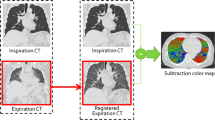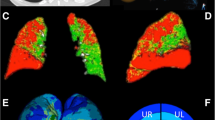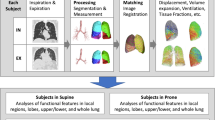Abstract
Objectives
To investigate the optimal threshold of subtraction method for quantification of air trapping on co-registered CT in COPD patients in correlation with pulmonary function parameters.
Methods
From June 2005 to October 2010, 174 patients were included in our study. Inspiration and expiration CT were performed followed by non-rigid registration using in-house software. The subtraction value per voxel between inspiration and registered expiration CT was obtained, and volume fraction of air trapping (air trapping index, ATI), using variable thresholds was calculated. ATI, expiration/inspiration ratio of mean lung density (E/I MLD) and the percentage of lung voxels below −856 HU on expiration CT (Exp−856) were correlated with FEF25–75% and RV/TLC.
Results
The highest correlation coefficient with FEF25–75% was −0.656, using the threshold of 80 HU. As for RV/TLC, the highest correlation coefficient was 0.664, using the threshold of 30 HU. When plotting the relationship between subtraction thresholds and FEF25–75% and RV/TLC, the threshold of 60 HU was most suitable (r = −0.649 and 0.651). Those correlation coefficients were comparable to the results with E/I MLD (r = −0.670 and 0.657) and Exp−856 (r = −0.604 and 0.565).
Conclusions
The optimal threshold for quantification of air trapping was 60 HU and showed comparable correlations with pulmonary function parameters.
Key Points
• The optimal CT threshold of subtraction method for air trapping was 60 HU.
• ATI with 60 HU threshold was comparable to E/I MLD and Exp −856 .
• Emphysema may substantially contribute to air trapping with statistical significance (P < 0.001).




Similar content being viewed by others
Abbreviations
- ATI:
-
Air trapping index
- COPD:
-
Chronic obstructive pulmonary disease
- DLco:
-
Diffusing capacity of lung for carbon monoxide
- E/I ratio:
-
Expiration/inspiration ratio of the mean lung density
- Exp−856 :
-
Percentage of lung voxels with attenuation below −856 HU on expiration CT
- FEV1 :
-
Forced expiratory volume in 1 s
- FEF25–75% :
-
Mid-expiratory phase of the forced expiratory flow
- FVC:
-
Forced vital capacity
- GOLD:
-
Global Initiative for Obstructive Lung Disease
- KOLD:
-
Korean Obstructive Lung Disease
- PFT:
-
Pulmonary function test
- RV:
-
Residual volume
- RV/TLC:
-
Ratio of residual volume to total lung capacity
- TLC:
-
Total lung capacity
References
Global Initiative for Chronic Obstructive Pulmonary Disease (2015) Global strategy for the diagnosis, management, and prevention of chronic obstructive pulmonary disease. Available via http://www.goldcopd.org/
Bergin C, Muller N, Nichols DM et al (1986) The diagnosis of emphysema. A computed tomographic-pathologic correlation. Am Rev Respir Dis 133:541–546
Muller NL, Staples CA, Miller RR, Abboud RT (1988) “Density mask”. An objective method to quantitate emphysema using computed tomography. Chest 94:782–787
Gevenois PA, De Vuyst P, de Maertelaer V et al (1996) Comparison of computed density and microscopic morphometry in pulmonary emphysema. Am J Respir Crit Care Med 154:187–192
Nakano Y, Sakai H, Muro S et al (1999) Comparison of low attenuation areas on computed tomographic scans between inner and outer segments of the lung in patients with chronic obstructive pulmonary disease: incidence and contribution to lung function. Thorax 54:384–389
Lee YK, Oh YM, Lee JH et al (2008) Quantitative assessment of emphysema, air trapping, and airway thickening on computed tomography. Lung 186:157–165
Nakano Y, Wong JC, de Jong PA et al (2005) The prediction of small airway dimensions using computed tomography. Am J Respir Crit Care Med 171:142–146
Hasegawa M, Nasuhara Y, Onodera Y et al (2006) Airflow limitation and airway dimensions in chronic obstructive pulmonary disease. Am J Respir Crit Care Med 173:1309–1315
Achenbach T, Weinheimer O, Biedermann A et al (2008) MDCT assessment of airway wall thickness in COPD patients using a new method: correlations with pulmonary function tests. Eur Radiol 18:2731–2738
Matsuoka S, Kurihara Y, Yagihashi K, Hoshino M, Nakajima Y (2008) Airway dimensions at inspiratory and expiratory multisection CT in chronic obstructive pulmonary disease: correlation with airflow limitation. Radiology 248:1042–1049
Hogg JC, Chu F, Utokaparch S et al (2004) The nature of small-airway obstruction in chronic obstructive pulmonary disease. N Engl J Med 350:2645–2653
Lee KW, Chung SY, Yang I, Lee Y, Ko EY, Park MJ (2000) Correlation of aging and smoking with air trapping at thin-section CT of the lung in asymptomatic subjects. Radiology 214:831–836
Tanaka N, Matsumoto T, Miura G et al (2003) Air trapping at CT: high prevalence in asymptomatic subjects with normal pulmonary function. Radiology 227:776–785
Hansell DM, Bankier AA, MacMahon H, McLoud TC, Muller NL, Remy J (2008) Fleischner Society: glossary of terms for thoracic imaging. Radiology 246:697–722
Newman KB, Lynch DA, Newman LS, Ellegood D, Newell JD Jr (1994) Quantitative computed tomography detects air trapping due to asthma. Chest 106:105–109
Mets OM, van Hulst RA, Jacobs C, van Ginneken B, de Jong PA (2012) Normal range of emphysema and air trapping on CT in young men. AJR Am J Roentgenol 199:336–340
Schroeder JD, McKenzie AS, Zach JA et al (2013) Relationships between airflow obstruction and quantitative CT measurements of emphysema, air trapping, and airways in subjects with and without chronic obstructive pulmonary disease. AJR Am J Roentgenol 201:W460–W470
Galban CJ, Han MK, Boes JL et al (2012) Computed tomography-based biomarker provides unique signature for diagnosis of COPD phenotypes and disease progression. Nat Med 18:1711–1715
Kim EY, Seo JB, Lee HJ et al (2015) Detailed analysis of the density change on chest CT of COPD using non-rigid registration of inspiration/expiration CT scans. Eur Radiol 25:541–549
Park TS, Lee JS, Seo JB et al (2014) Study design and outcomes of Korean Obstructive Lung Disease (KOLD) Cohort Study. Tuberc Respir Dis (Seoul) 76:169–174
Miller MR, Crapo R, Hankinson J et al (2005) General considerations for lung function testing. Eur Respir J 26:153–161
Akira M, Toyokawa K, Inoue Y, Arai T (2009) Quantitative CT in chronic obstructive pulmonary disease: inspiratory and expiratory assessment. AJR Am J Roentgenol 192:267–272
Mets OM, Murphy K, Zanen P et al (2012) The relationship between lung function impairment and quantitative computed tomography in chronic obstructive pulmonary disease. Eur Radiol 22:120–128
McFadden ER Jr, Linden DA (1972) A reduction in maximum mid-expiratory flow rate. A spirographic manifestation of small airway disease. Am J Med 52:725–737
Burgel PR (2011) The role of small airways in obstructive airway diseases. Eur Respir Rev 20:23–33
Matsuoka S, Kurihara Y, Yagihashi K, Hoshino M, Watanabe N, Nakajima Y (2008) Quantitative assessment of air trapping in chronic obstructive pulmonary disease using inspiratory and expiratory volumetric MDCT. AJR Am J Roentgenol 190:762–769
Acknowledgments
The scientific guarantor of this publication is Dr. Joon Beom Seo. The authors of this manuscript declare no relationships with any companies whose products or services may be related to the subject matter of the article. This study has received funding by a grant of the Korea Healthcare Technology R&D Project, Ministry for Health and Welfare, Republic of Korea (Grant number: HI11C1552 and HI10C2020). No complex statistical methods were necessary for this paper. Institutional review board approval was obtained. Written informed consent was obtained from all subjects (patients) in this study. Some study subjects or cohorts have been previously reported in Kim et al.’s study (Eur Radiol 2015;25:541–549). Methodology: retrospective, diagnostic or prognostic study, performed at one institution.
Author information
Authors and Affiliations
Corresponding author
Rights and permissions
About this article
Cite this article
Lee, S.M., Seo, J.B., Lee, S.M. et al. Optimal threshold of subtraction method for quantification of air-trapping on coregistered CT in COPD patients. Eur Radiol 26, 2184–2192 (2016). https://doi.org/10.1007/s00330-015-4070-z
Received:
Revised:
Accepted:
Published:
Issue Date:
DOI: https://doi.org/10.1007/s00330-015-4070-z




